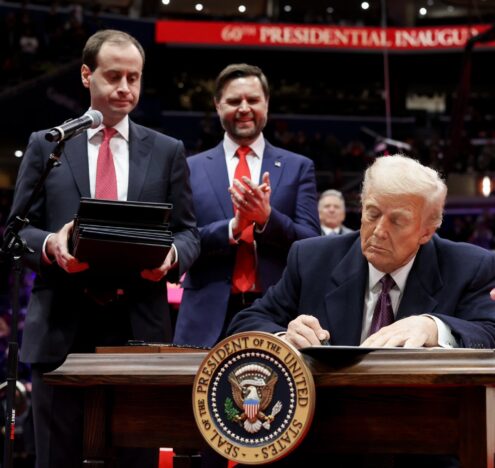The Quad leaders’ summit in March of this year was widely covered as a coming out party for a previously rather obscure 4-nation group of China rivals — Japan, Australia, India, and of course, the United States. Though the Quad had been meeting regularly at more junior levels since 2017 (after its original short-lived founding in 2007), the leaders’ summit resulted in the first joint statement, giving the impression that the four nations were closely aligned.
The Quad is not a formal organization — it has no secretariat, no charter, not even a website. Most of the Quad’s three year life so far has been taken up with meeting and issuing statements. Until the leaders’ summit, these were issued separately by each member. No wonder some have dubbed the grouping a talk shop.
However, what the four nations have been doing outside of the official Quad format is more than talking. President Joe Biden has focused on defining China as the greatest geopolitical threat to the United States, promising “extreme competition” with Beijing. Thus, the last few years have been heavily focused on ramping up interoperability between the four nations’ militaries through “foundational agreements” enabling the use of each other’s bases for refueling and other purposes and placing US-sourced communications and geospatial equipment in US-origin aircraft and naval ships.
In practice this has been mostly about India, as I explained in a recent brief from the Quincy Institute of Responsible Statecraft. New Delhi is the only Quad member outside formal US alliance structures. Closing the gap between India and other US allies has long been a top Washington priority. India too has recently come to blows with China on their contested border. And now, the Quad nations effectively have their own military exercise, the Malabar. Thus, even as Quad leaders stressed non-military cooperation in their summit, facts on the ground look increasingly like the formation of a military bloc — which could be a destabilizing development in Asia.
But there is a better way. The Quad should repurpose itself toward meeting the sort of threats that can unite rather than divide bitter rivals in Asia. One of these threats — climate change — has been declared as “existential” by the United States itself.
CENTERING CLIMATE ACTION
What could the Quad do to prove its value in overcoming the climate crisis? The leaders’ summit took a good step forward by setting up a working group on climate change (as also on vaccines and critical technologies). The challenge is now to translate the rhetoric into action.
Four pillars form the United Nations-led international climate framework — mitigation, adaptation, technology, and finance. A fifth arena could be added to this list, namely climate security. The Quad summit emphasized all of these, except security, as a focus for its new working group. However, mitigation is already a major global focus of UN Conference of the Parties (COP) negotiations, and finance may be best handled through a different format, such as the multilateral development banks and the Green Climate Fund. The Quad could be more suited to tackle adaptation, security, and technology.
The leaders’ summit took a good step forward by setting up a working group on climate change (as also on vaccines and critical technologies). The challenge is now to translate the rhetoric into action.
Quad members make up a geography in a rough arc, stretching from US territories in the Pacific through northeast Asia to southwest Asia. Contained within this arc is the critical region of Southeast Asia, home to some of the world’s most climate vulnerable countries, such as Philippines, Cambodia, Vietnam, Myanmar, and Indonesia. Some of these, most prominently Myanmar, are also wracked by security crises.
If there is a terrain for the Quad to demonstrate its worth on climate change, it is Southeast Asia, which also contains a cohesive regional organization, the Association for Southeast Asian Nations (ASEAN). ASEAN members have been wary of the Quad thus far, with one of them dubbing it a “military alliance.” However, they might be more willing to associate with the group if its emphasis became climate action rather than military bloc-building.
South Asia, with its regional organization South Asian Association for Regional Cooperation (SAARC), could conceivably be another such terrain. SAARC, however, is quite ineffectual thanks to the tense India–Pakistan rivalry, which shows few signs of abating. The Quad could engage individual countries, such as Sri Lanka and Bangladesh, if they were convinced it was not a China-balancing grouping.
The low-hanging fruit on climate security is Humanitarian Assistance and Disaster Relief (HA/DR). In fact, the genesis of the Quad can be traced to HA/DR activities in response to the Asian tsunami of 2004, in which all four members of the grouping took part. As climate change wracks Asia, HA/DR activities will be increasingly in demand in the Bay of Bengal region that encompasses several South and Southeast Asian states, including Quad member India.
But an over-reliance on HA/DR is in a sense an admission of failure of prevention strategies. Thus, adaptation and resilience are in some ways even more important. The Quad could help set up or further strengthen existing early warning systems for natural disasters, such as cyclones or Glacier Lake Outburst Floods (GLOF) in the Himalayas. There is also the need for more granular modeling of the Asian monsoon that is likely to see increased spells of very heavy rainfall and consequent floods with global warming.
CLIMATE ACTION AS A BRIDGE TOWARD ASIAN COOPERATION
Adaptation is also about strengthening physical and human resilience. This admittedly could cover a kitchen sink of issues — infrastructure, education, health, water, agriculture, and urban planning among others. It may be best for the Quad to pick one or two of these and stick with them.
Infrastructure is already a part of the Quad’s agenda. But rather than obsess about competing with China’s Belt and Road Initiative (BRI), the Quad could focus on the types of infrastructure projects that increase adaptive capacity of vulnerable communities and cities. This could include shoring up infrastructure of climate-vulnerable military bases of members and other partners in the region. Sustainable urban planning — for example, in climate-threatened coastal cities —could also be a key target.
The Quad centering its mission on adaptation, infrastructure, and climate security also has another potential benefit — the inclusion of China. It is well-recognized that Beijing must be part of any solution to climate change. Attempting climate cooperation with China as a means to lessen tensions in Asia ought to be a priority for the Quad. There is no reason why less sensitive tasks, such as joint HA/DR training exercises and missions and scientific cooperation for more granular climate forecasting, cannot be conducted with Beijing and other Asian states’ participation. More ambitious issues, such as helping resolve contestations over climate-stressed river basins, such as the Brahmaputra and the Indus as analyzed by a new study, can be a more discreet, longer-term goal, linked to a wider detente in the region. In sum, a climate-focused Quad may be the bridge we need to a less confrontational and more cooperative Asia.
Sarang Shidore is Non-Resident Fellow at the Quincy Institute for Responsible Statecraft. He is also Senior Fellow at the Council on Strategic Risks and Senior Research Analyst at the LBJ School of Public Affairs at the University of Texas at Austin.




















